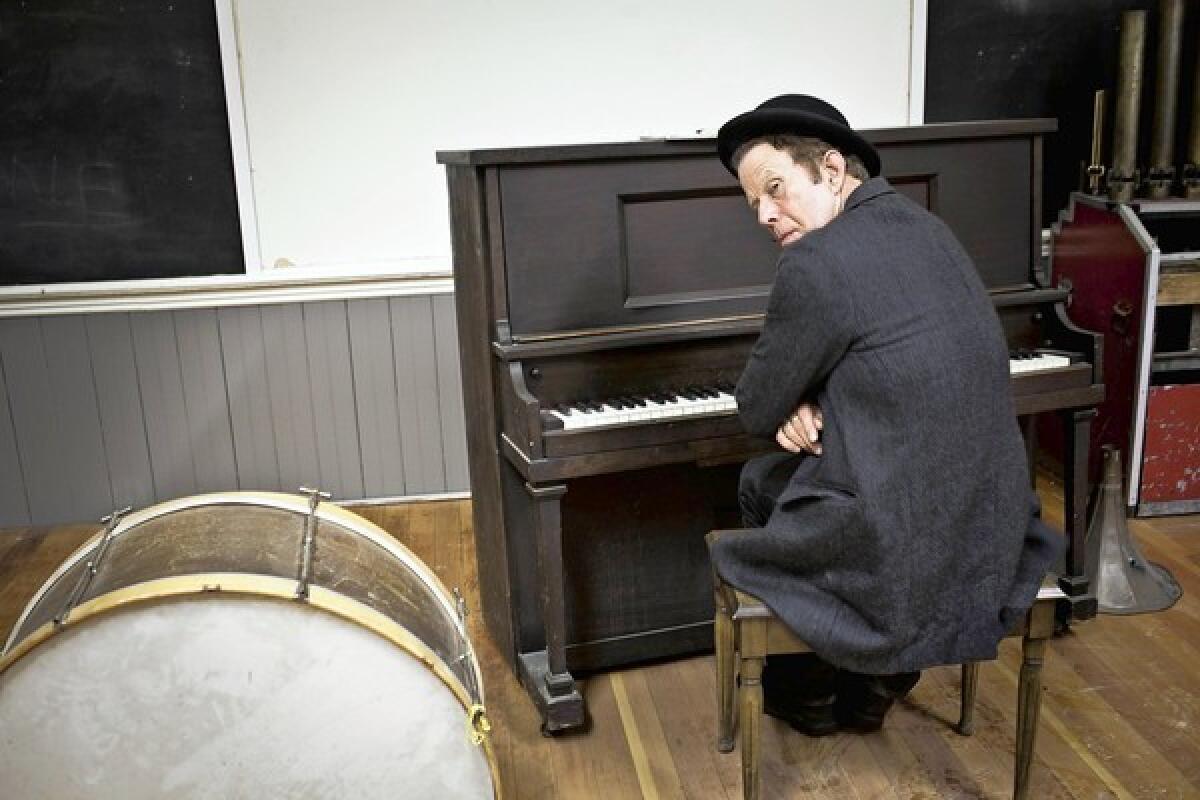Critic’s Notebook: The lowdown with Tom Waits

- Share via
Reporting from Petaluma, Calif. — — Over the course of three hours of conversation at a roadside diner here called Pete’s Henny Penny, Tom Waits, the singer, songwriter, pianist, arranger, actor and note taker, will offer the following similes and metaphors, seemingly at random though just as likely cataloged in his memory for future use: an aging musician as “a Popsicle in the sun on a bus bench in Florida”; the process of creation as “like making Chinese food — it’s very exotic and it takes a lot of time”; the Henny Penny as “privately owned, like I am”; and a woman losing her wedding ring near a lake, biting into it later when eating fish, and how such magical irony may or may not have something to do with the way Waits and his longtime collaborator-wife, Kathleen Brennan, create songs.
Waits, 61, had walked into the diner just off Highway 101 around lunchtime last week wearing blue jeans and a jean jacket and carrying a black leather bag the size of a briefcase fastened shut with buckles and packed with whatever it was that I’ll always regret not asking about. (Notebooks? Change of clothes? Horse manure?)
He sat down in a booth, dropped a few pocket-sized notebooks on the table — messages and reminders regarding his new album, “Bad as Me” — and ordered a cup of decaf. He lives somewhere around here in Sonoma County with his wife — his three children are all in their 20s now — and will swing by the diner from time to time when he’s “washing the dishes,” his term for the requisite media rounds that accompany the release of new music after the feast that is creating it.
The singer with the lowdown Howlin’ Wolf yowl, which is richer and more elastic than ever on “Bad as Me,” still has a mound of dark brown hair, same style, though thinner, that he’s worn since his first album in 1973. The Whittier native but longtime Northern Californian swung by the 24-hour restaurant to talk about studio album No. 20 (give or take), being released Monday on Los Angeles-based Anti- Records, his first new studio album in seven years, and one of the best of his wildly fruitful creative life.
Waits, of course, has his own take on the new work. The born raconteur, whose way with words has created such American classics as “Downtown Train,” “Jersey Girl,” “I Don’t Wanna Grow Up” and the perfect midperiod classics “Swordfishtrombones,” “Rain Dogs” and “Frank’s Wild Years,” takes a sip of coffee, opens one of his notebooks and reads some of his scribbled words on “Bad as Me.”
“If I was listening to this, and I didn’t know me,” he says by way of introduction, “the notes that I would make” — his voice takes on a tone of authority — “He’s a soul man in chain mail on a burnt rocking horse. Brutal lurching. Strange train set. Come on, put your stumps together. Clear water from a dirty glass. Studly vibrato. Songs of broken trust. The riddle of death in the face of war.”
Process of creation
After settling in by addressing the futuristic insect-sized drones that he says the government has developed and the “aviaries” that house them, Waits edges closer to a discussion about making “Bad as Me.” He much prefers talking around the process of creation to talking about the finished work, as if to poke at it too much would disturb the humming hornet’s nest that generated it.
The record, however, swirls with adventure and includes the instant classic ballad “Back in the Crowd,” the stomping march “Hell Broke Luce” and the transcendent closer “New Year’s Eve,” a quiet yarn of a waltz.
Waits and Brennan populate these songs with a cast of characters that include Mackey Debiasi (“a complicated man”), Nimrod Bodfish (“have you any wool?”), Ice Pick Ed Newcomb (“on a slab in the morgue”). A guy named Calvin recommends that the narrator of “New Year’s Eve” go back to driving a truck; Geoff, who was a chef before he died in battle, is recalled in “Hell Broke Luce,” a war lament, as is Sergio, who’s “developing a real bad cough” while fighting. They’re meth heads and soldiers, revelers and tight-sweatered ladies, many rich with enough detail to build one-acts around.
As they have done since his transformative “Swordfishtrombones” in 1983, Waits and Brennan, listed as co-writer on all songs, have created tunes that draw from all corners of folk and popular music. Few if any artists working today contain these foundational multitudes that make Waits a composer who’s absorbed the breadth of 20th century musical instrumentation so completely that it’s melted into one beautifully chaotic thing.
He’s done this gradually, over time. His work in the 1970s relied on standard instrumentation — mostly Waits on the piano with smoky-jazz accompaniment. But as he moved into the ‘80s and married Brennan, herself a screenwriter and playwright, the musical palate expanded greatly. Where once he banged on pianos, he now bangs on everything, and he weaves layers of sound, dust and melody throughout.
You’re just as likely to hear hints of rockabilly as Brechtian song cycles; blues and show-tune sounds blend together with gospel hand claps and baritone sax runs that sound ripped from classic doo-wop; avant rock mergers with soul and R&B; his big-tent music includes nods to Gypsy ballads, Mexican rancheras, foot-stomping Sousa marches, sad, violin-scratched laments and sweet, Sinatra-esque love songs. Vocally, he channels Elvis Presley, Don Van Vliet, Louis Armstrong, Blind Willie Johnson and Billie Holiday.
James Booker-esque barrelhouse piano rolls on the slow-galloping “Talking at the Same Time.” It wobbles with a pedal steel as Waits, in a raspy falsetto, captures in couplet America 2011: “Well we bailed out all the millionaires / They’ve got the fruit, we’ve got the rind / And everybody’s talking at the same time.” References to war and class permeate the record, though much of it indirectly. Mortality, especially, is on his and Brennan’s minds, most successfully in “Last Leaf.”
I fight off the snow
I fight off the hail
Nothing makes me go
I’m like some vestigial tail
I’ll be here through eternity
If you want to know how long
If they cut down this tree
I’ll show up in a song
Busy during break
Waits says there’s no real reason why it took seven years between “Bad as Me” and 2004’s “Real Gone,” which has sold 202,000 copies in the U.S., according to Nielsen SoundScan. In the interim, he did some acting gigs (“The Book of Eli,” “The Imaginarium of Doctor Parnassus”) and released a triple-disc collection of outtakes and unreleased songs called “Orphans: Brawlers, Bawlers & Bastards.” As well, he undertook an acclaimed Glitter and Doom tour and issued a live document of it.
“I haven’t been fishing,” he says of the time away from the studio. Touring is his least favorite part of the musicmaking cycle, though he says he’d like it much more if his was a traveling family band. Thus far, he has no plans to take “Bad as Me” on the road.
He has, however, been camped out in the metaphorical natural world listening for signals. “You just have to be ready,” he says of his relationship with inspiration. “It’s like nature photography. You have to be in a bunker with a piece of plywood and a camera and sit there for three days. You have to be watching. And it happens. And it happened with all of the people who played on this record.”
Those people include both Waits regulars and occasionals, most notably Red Hot Chili Peppers bassist Flea, Los Lobos multi-instrumentalist David Hidalgo, Les Claypool of Primus, Waits’ son Casey on drums and longtime guitarist Marc Ribot, along with Keith Richards on guitar and backing vocals on the exquisite lament “Last Leaf.” (Richards, in fact, comes up lyrically in the fantastic “Satisfied,” in which Waits declares confidently that “Mr. Jagger and Mr. Richards … will scratch where I’ve been itching.” Waits says Richards “got a kick out of it.”)
“Once you sit down and decide, ‘OK, we’re going to write some tunes,’ then you’ve begun. But you’re either absorbing or you’re secreting, and sometimes a little bit of both at the same time. Everything you listen to and see is somehow going in there, and it’ll find its way out in one form or another.”
Waits cites as an example the strange birth of the song “Raised Right Men,” a sturdy blues with classic James Bond/John Barry brass bursts and Waits’ gruff throat complaining about worthless men and the trouble they carry. The song got its start as a playful interaction between Waits and Brennan about the morning coffee, he recalls. Riffing on Johnson’s call-and-response version of “John the Revelator,” whenever Waits would bring Brennan her coffee, he’d sing, “Who’s the bring-alator?” and she’d answer, “You’re the bring-alator!”
Brennan soon introduced “raised-right men” as a phrase she’d sing to him in the same fashion. “We were throwing it back and forth: ‘There ain’t enough / Raised-right men.’ It was an attempt to do an Aretha song, something Aretha would say, like ‘Be a do-right man.’ This was like, ‘There ain’t enough raised-right men. Where are all the raised-right men?’ And we made some examples. The guy in the toll takers’ booth? There’s your trouble right there. His head was so thick she had to knock out a tooth.”
Waits’ blue eyes light up as he recalls his playful interaction with Brennan. “So, we had this little exchange going back and forth, a little litany. Sometimes, songs come out of other songs. The eggs are always inside other songs waiting to be broken open or fertilized, or released in just the right weather conditions. Who knows why? It’s a mystery, and I’m filled with wonder about it. And it’s probably why I keep doing it. If it happened every time, I’d stop doing it.”
More to Read
The biggest entertainment stories
Get our big stories about Hollywood, film, television, music, arts, culture and more right in your inbox as soon as they publish.
You may occasionally receive promotional content from the Los Angeles Times.








